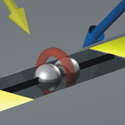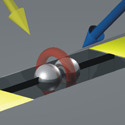How to build a nanoscale atom trap
One of the next stages in making traps for ultracold, neutral atoms is miniaturization. With traps that are only a few nanometers in size, one could imagine, for example, engineering chips that contain an array of traps for exploring nanoscale optics.
The main difficulties with actually making a nanoscale atom trap are that the atoms tend to be attracted to the walls of the trap and are susceptible to heating from nearby sources. Writing in Physical Review Letters, Brian Murphy and Lene Vestergaard Hau at Harvard University are exploring one idea that could overcome these obstacles. In their proposal, a laser traps an atom between two silver spheres, less than in size, that are suspended on top of a carbon nanotube. Laser cooling and trapping of atoms is a well-developed technique, but in this case the presence of the two metal spheres introduces an additional, repulsive electric field that, when combined with the laser field, traps the atoms between the spheres, but not in direct contact with their surfaces. (The additional field arises because the laser excites collective oscillations—called plasmons—of the conduction electrons in the spheres.)
Murphy and Hau perform simulations of how an atom moving several meters per second—a typical velocity for an atom launched from a magneto-optical trap—could couple to plasmons and lose enough energy to fall into the nanotrap. Assuming such a trap could be built, it would provide an opportunity to explore the purely quantum mechanical forces between an atom and a surface. – Jessica Thomas





